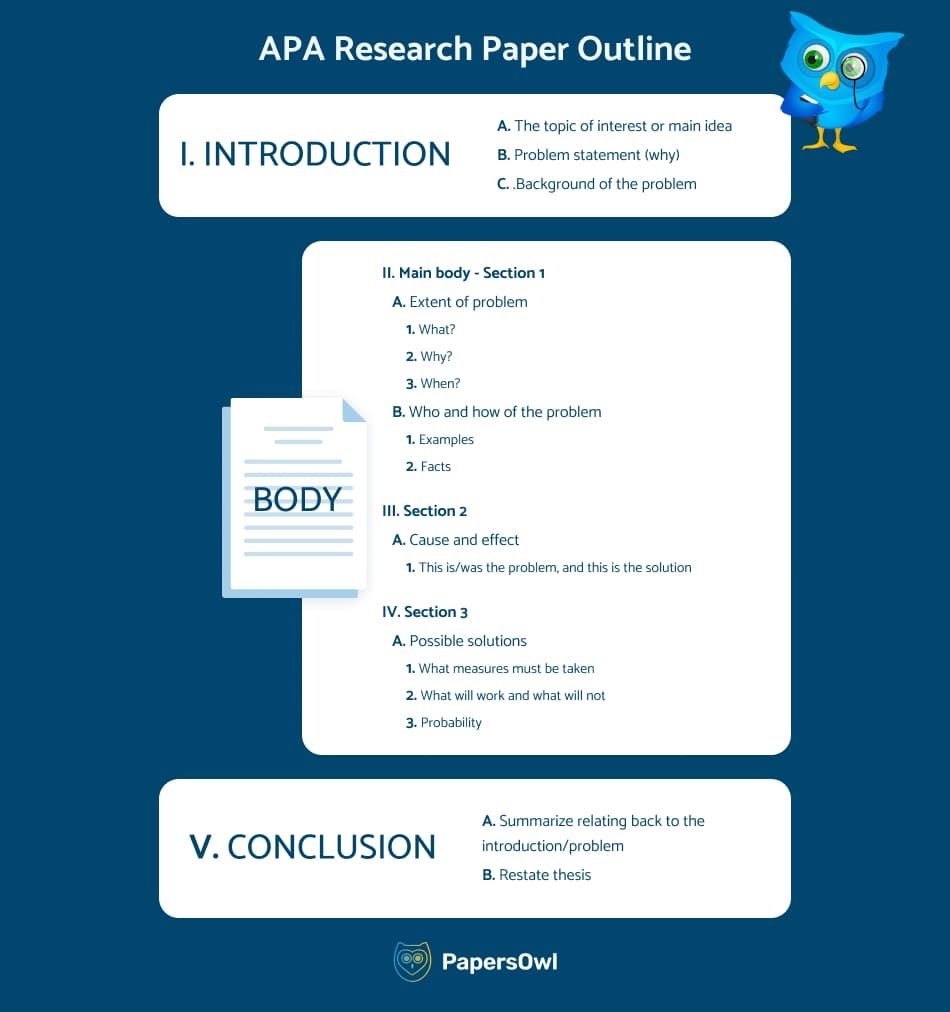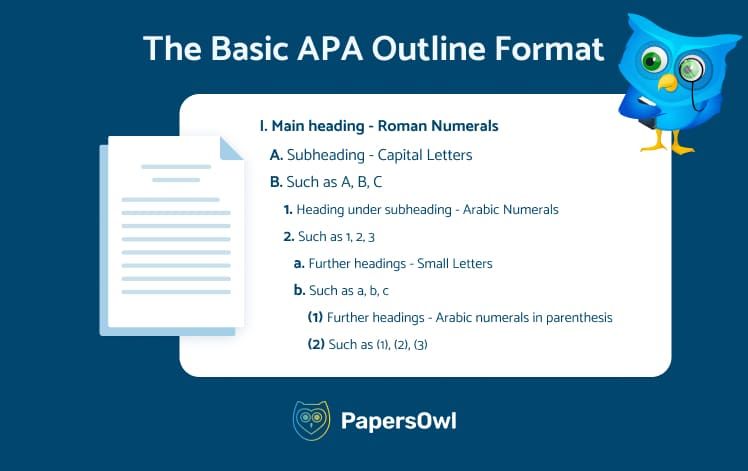APA Research Paper Outline
Table of contents
- 1 Why Is Structure Important in APA?
- 2 Concept & Purposes of Research Paper Outline
- 3 APA Outline Example
- 4 The Basic APA Outline Format
- 5 APA Style Outline Template Breakdown
- 6 Full Sentence Outline Format
- 7 Decimal Outline Format
- 8 Tips for Writing an Outline
- 9 How to Create an APA Format Paper Structure
- 10 APA Research Paper Structure
- 11 Key APA Formatting Rules
- 12 In Wrapping Up
Formatting your paper in APA can feel overwhelming. It is really true, especially for college students.
The official publishing handbook created by the American Psychological Association provides specific guidelines. They help structure your future research or professional papers clearly and consistently.
Applying these rules — from the title page and author note to the reference list — is key to writing in APA 7 format. Use an APA format outline template to organize the ideas before drafting the full paper.
To make this process easier, ensure you follow the APA title page formatting guidelines, which outline the correct structure for presenting your title and other essential details.
If you are looking for a quick answer to how to structure an APA paper, here’s a standard logical sequence of typical parts:
- Introduction;
- Thesis statement;
- Materials;
- Techniques employed;
- Body of paper;
- Findings;
- Conclusions section;
- List of references.
A well-written outline is an excellent tool for presenting outstanding student papers. It is necessary to include the key components when writing a research paper.
Why Is Structure Important in APA?
Consistency in the order, structure and format of a research paper allows the reader to focus on the content not the presentation. The paper format requirements apply to professional papers and student assignments submitted for publication in a peer-reviewed journal. The APA research paper outline template can be used for a website, conference poster or presentation.
If using APA for a slideshow or infographic, adjust spacing, font and headings according to your school or publication’s rules. For example the title page may need different line spacing and font sizes. Follow the formatting rules provided by your institution or publication to meet its formatting standards. But to structure your document logically you need an APA paper outline.
You might wonder why an outline matters in APA — think of it as your paper’s blueprint. Creating an organized APA outline is crucial for any paper. If you’re struggling with it, consider getting help from a professional research paper writer.
Concept & Purposes of Research Paper Outline
It’s easy to skip outlining for short student papers, but structure becomes essential for anything over 2,000 words. Just remember: a table of contents lists sections, while an outline shows how ideas fit together.
The table of contents is an orderly list of all the chapters’ front matter, primary, and back matter. It includes sections and, often, figures in your work, labeled by page number. On the other hand, a research APA-style paper outline is a proper structure to follow.
An outline maps out your argument and helps organize supporting points before you start writing. And when you write your APA outline template, you expand on what you already know about the topic.
Student papers often explore topics using the most up-to-date and credible sources. It serves various purposes, including:
- The research paper outline APA discusses the study’s core concepts.
- The research paper outlines how to define the link between your ideas and the thesis.
- It provides you with manageable portions that you can handle.
- The paper’s APA outline enables the detection of structural faults or gaps.
- Your layout should reflect a clear understanding of your topic and logical flow.
APA Outline Example
This paper outline example will guide you in formatting the layout so that you have a clear direction to work on. It will also help you stay focused and consistent throughout the paper.

The APA manual doesn’t require a single outline style but provides formatting rules. APA 7 doesn’t include strict outline rules, but your professor might. However, it requires certain basic guidelines regarding typeface, font size, structure, margins, etc.
Moreover, the final shape of your work relies on your instructor’s specifications and your particular preferences for APA citation format. Still, using a clear outline format makes it easier to stay organized, for instance:
- Font: Times New Roman is a widely accessible standard typeface for an APA essay format in 12-point font. However, serif and sans serif fonts like Arial and Georgia are acceptable in font size 11pt.
- Spacing: The text of your paper in APA format should be double-spaced.
- Numerals: The primary headlines use Roman and Arabic numerals to write an outline.
- Headings & Subheadings: While writing an APA essay, there are particular standards for utilizing headings in your outline:
I – Main headings are numbered by Roman numerals like I, II, III, IV
A – Subheadings are numbered with Capital letters (A, B, C, D)
1 – The APA outline uses Arabic numerals (1-9 type numbers) within those subheadings
a – Below Arabic number subheadings, lower-case letters are used (a, b, a)
[1] – Headings below those subheadings use Arabic numbers enclosed in parenthesis
- Margins: APA format offers a standard layout for each paper, such as
- 1-inch margins on the top, bottom, left, and right
- The page number on the upper right corner
- Structure: The structure of writing an outline consists of three major sections:
- Introduction: This section highlights crucial background information.
- Main body: Explain the primary points that support your ideas.
- Conclusion:
– Summarize your key arguments.
– Explain how these concepts support your ultimate stance, as shown in the APA outline example below.
An outline in APA has three common formats, each with a different numeric sequence. To make it easier for you, we have compiled all three templates. You can format your document using these examples for added coherence and structure.
The Basic APA Outline Format
The rudimentary schema customarily comprises a triadic arrangement: principal rubrications, subsidiary delineations, and further subheadings under them if necessary. They all have specific numerical representations.
If you are unsurehow to write a research paper outline, here is an example of the basic format.

APA Style Outline Template Breakdown
The APA style format follows five levels of headings that use different alphabets and numbers. For instance:
I – Headings use Roman numerals like I, II, and III
A – CAPITAL ALPHABETS”, such as A, B, C, etc
1 – Headings and subheadings use Arabic numbers (1, 2, 3)
a – If there are further headings (the fourth level), use lower-case alphabets
[1] – Headings below that (the fifth level) use Arabic numerals enclosed in parentheses, such as [1], [2], [3]
Full Sentence Outline Format
As the name specifies, this outline format requires every line to be a proper sentence. A full-sentence APA style outline is best recommended for essays and speeches. It gives your draft structure and helps you stick to your argument.
Full-sentence outlines should read like clean, natural prose, If sentences feel formulaic, Humanizer AI can humanize them while preserving structure and intent.
If you are looking for how to write a research paper outline in APA in Full Sentence Format, here is an example:
Full Sentence APA format heading utilizes Roman numerals I, II, and III. Every heading must be a full sentence. Here is an APA-style paper outline template that will clear all your confusion about how to write an outline in full-sentence format.
APA Paper Outline Format Example
I. Introduction
II. Body
III. Conclusion
Decimal Outline Format
This outline format for APA research papers differs from other formats. The decimal APA style is simple and uses paragraphs for structure. It contains three main paragraphs: introduction, main body, and conclusion.
First Paragraph: Hook and Thesis
- The first paragraph is a sentence or two that introduces the central concept of your article.
- Introduce your topic or subject of study where your research is applicable as a context for further research.
- Explain why the mentioned issue is essential or relevant to the audience.
- A thesis statement is a claim that you make throughout your whole essay.
Main Body
- The topic phrase is the first point in any writing to support a thesis statement.
- Explain or provide evidence to support your point.
- Provide verifiable facts, figures, and/or citations from relevant studies in your writing. It helps in substantiating the assertion.
- Include as many supporting statements and related evidence in your decimal outline.
Conclusion
Finally, when you write an outline, provide a concluding remark to support your claims.
Decimal APA Outline Format Example
1.0 The main heading
1.1 Subheading under the main heading
1.2 Second digit is represented by subheadings under the main headings
1.2.1 Further division adds another digit in decimal format
1.2.2 You can number them as per the number of paragraphs or points, or lines
An easy way to write in decimal APA outline format is to remember the structure, i.e.;
1.1.1 = Heading.Paragraph.Sentence/point under paragraph.”
Decimal APA Outline Format Layout
1.0 Main heading
1.1 First paragraph for first heading.
1.2 Second paragraph for first heading.
1.2.1 First point or sentence for the second paragraph.
2.0 Second heading
2.1 Second heading, first paragraph.
2.2 Second heading, second paragraph.
2.2.1 Second, heading, second paragraph, first sentence, or point.
3.0 Decimal working
3.1 You must remember that each digit represents a segment.
3.2 It is easier to remember the placement of numbers.
3.2.1 First digit represents the heading
3.2.2 Second digit represents the paragraph under the main heading
3.2.3 The third digit represents any point or sentence under the paragraph.
Tips for Writing an Outline
You may feel it is easier to write without outlines, but organizing your ideas or thoughts becomes hard once you start writing. Even strong ideas can fall apart without a solid structure.
A well-written outline is essential in completing your paper and maintaining quality. You can find a template that best suits your requirements. These tips and sample student papers can help you write outstanding outlines without hassle.
- A Definite Goal. Start by writing your main goal or thesis at the top — keep it clear and focused. Your goal should be specific and measurable. If it is too broad or imprecise, you will not achieve anything.
- Division. Breaking things up rather than allowing them to become verbose is known as the division rule. Make sure that each subsection in the document corresponds to its parent heading.
- Parallelism. It is mainly related to the consistency and structure of the document. It keeps your paper’s layout tidy and also ensures relevancy. For instance, if you begin one heading with a verb, ensure all other headings and subheadings also start with a verb.
- Coordination. Having headings aligned is critical to creating a well-organized outline. This rule also applies to subheadings, which is a good thing. If one page header is less important than another, consider changing your layout by incorporating it into a subsection instead.
- Subordination. Subordination deals with maintaining a connection between your paper’s headings and subheadings. It helps in the proper sequencing of headings and subheadings. Headings should be broad at the outset.
- Avoid Redundancy. While writing a paper outline, look through it many times and cross out any items that aren’t necessary or have no significance. While outlining, make sure to be specific and concise.
- Wrap it Up in a Good Way. Creating an outline not only helps in writing a coherent term paper, but it also helps in ending with a precise understanding. Be considerate of your audience’s time and effort when you write an outline in APA, and ensure it serves its purpose.
How to Create an APA Format Paper Structure
If you’re unsure where to begin, follow this algorithm to create a clear, correctly formatted outline from scratch:
Step 1: Understand Your Assignment. Double-check the paper length, type (analytical, argumentative, etc.), and your professor’s outline preferences (decimal or full-sentence format).
Step 2: Define Your Research Question and Thesis. Clearly state your main argument or research methods, and purpose. This will guide the structure of your outline and help you stay focused.
Step 3: Choose Your Outline Format. APA allows two main types:
- Full-sentence outline: Each point is a complete sentence.
- Decimal outline: Uses a number hierarchy (1.0, 1.1, 1.2) for structure.
Step 4: Identify Main Sections of Your Paper. These often mirror APA paper sections:
- Introduction;
- Literature Review;
- Method;
- Results;
- Discussion section;
- Conclusion.
Step 5: Break Each Section into Subpoints. Use bullet points, decimal levels, or indentation to list supporting arguments, evidence, or citations. Follow APA formatting:
- Use double spacing, 12-point Times New Roman, and 1-inch margins.
- Capitalize all major words in headings.
- Maintain parallel structure (keep your grammar consistent across points).
Step 6: Review Hierarchy and Logic. Ensure your outline flows logically and each subpoint directly supports its parent point. Keep levels balanced — don’t overload one section and ignore another.
Step 7: Format According to APA Guidelines. Label sections clearly. You can use bold or italics for headers, but make sure it’s consistent and not stylized beyond APA manual norms.
APA Research Paper Structure
Your outline is the skeleton — your full APA paper is the body. Understanding how the outline maps to each section of a standard research paper helps you write purposefully and stay organized. If you find the process overwhelming, you can always turn to an APA paper writing service to ensure your paper is structured correctly and meets all academic standards.
Here’s how a typical APA research paper is structured, and where your outline guides each part:
| APA Paper Section | Purpose | Outline Reference |
| Title Page | The title page contains the paper title, running head, author, institutional affiliation, course, and date. Institutional affiliation is usually included in the author’s note. (A running head is no longer required in APA 7) | The title page is not usually included in the outline |
| Abstract | Summarizes your research in ~150–250 words | Often planned separately |
| Introduction | Presents the topic, background, and thesis statement | Matches intro-level headings in outline |
| Literature Review | Discusses relevant existing literature and prior research | Outlined as a major section |
| Method | Explains how the study was conducted | Labeled as “Method” |
| Results | Presents findings from the data analysis without interpretation | Usually mirrored as a heading |
| Discussion | Interprets results, discusses implications | Outlined with subpoints for clarity |
| Conclusion | Summarizes key insights and offers final thoughts | A final-level section |
| References | Lists all cited sources in APA 7th style | Not in the outline, but noted as required |
| Appendices (if needed) | Includes raw data, tools, or supplemental materials | Mentioned if relevant |
Key APA Formatting Rules
The following table summarizes essential APA 7th edition guidelines for professional papers:
| Formatting Element | APA Rule |
| Font | Use a readable font like 12-pt Times New Roman, 11-pt Arial, or 11-pt Calibri |
| Spacing | Double-space all lines (no extra space between items) |
| Margins | 1-inch margins on all sides |
| Indentation | Use hanging indent or consistent indentation for sublevels |
| Page Numbers | Include page numbers in the top right corner |
| Heading Levels | Use bold for section headings; subheadings may be italicized or left plain |
| Alignment | Align text to the left; do not justify |
| Labeling | Use Roman numerals, capital letters, Arabic numerals, and lowercase letters |
| Title Page Format | Center the page header at the top of the title page (no bold, italics, or underline) |
In Wrapping Up
People find it hard to write an outline in APA (American Psychological Association format), but if you are aware of the requirements and structure, it’s no breeze.
Sometimes, your instructor may alter your paper format by introducing or removing existing sections. As a result, if you come across any templates for an outline in APA, pay close attention to them.








